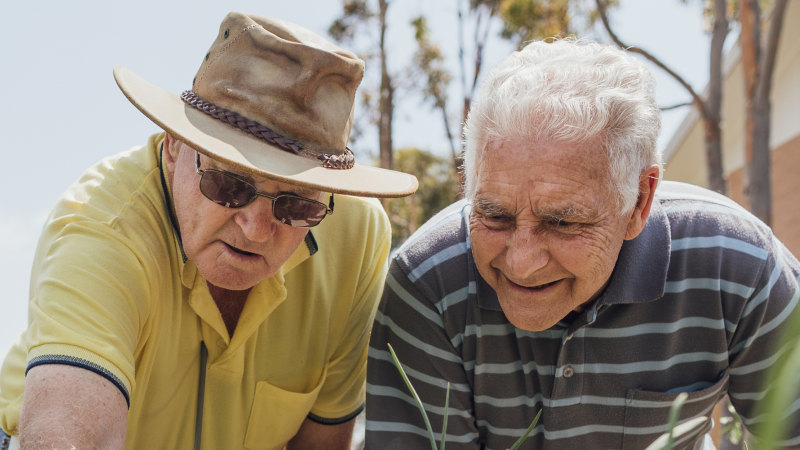[ad_1]
Like other nature-based activities, gardening may derive some of its benefits from reducing stress. The attention restoration theory hypothesises that natural stimuli may decrease mental fatigue by gently holding our attention with “soft fascination”.
But one trait that makes gardening stand out is that it “requires active participation” and “getting the hands in the dirt”, says Litt, who’s also a professor of environmental studies at the University of Colorado at Boulder. “You have to do something.”
With weeding, watering, digging, sowing, pruning and other such horticultural duties, gardening can be a physically demanding hobby. And physical exercise has also been shown to improve mental health.
Growing greens and cultivating connections
Gardening may not only help connect us to nature, but with other humans. Community gardening in a shared space can build trust, as people look after one another’s plots of land, and offer help and advice. This social growth is slow and steady, grounded by a shared purpose, a sense of belonging and learning. “All of it is textbook on how you build strong relationships,” Litt says. And the “garden calls them to come back because they have a responsibility”.
But even gardening at home is linked to greater social connectedness. In earlier research, Litt and her colleagues found that home gardeners were more socially involved – more likely to communicate with local MPs or participate in parent-teacher associations, for example – than non-gardeners.
Home gardeners were also more likely to positively rate the aesthetics of their neighbourhood. Both the increased social involvement and aesthetics ratings were associated with better health. Participating in community gardening further enhanced these effects.
Other research has found that gardening in the front yard, where the fruits of your labor are more visible, may also foster social connections and better mental health, says Lauriane Suyin Chalmin-Pui, an independent researcher in Britain specialising in the influence of gardening on wellbeing.
In one study, Chalmin-Pui and her colleagues transformed 38 bare front yards into gardens for 42 participants. Three months later, the study participants reported lower stress and had healthier cortisol patterns.
The gardens provided more opportunities for participants to bump into their neighbours, and the plants provided an easy conversation starter. When Chalmin-Pui followed up with the participants after a year-and-a-half, she found that people had gotten to know their neighbours.
Loading
Some had lived on the same street for 10 years. “But it was only after they both got plants in their front yard that they actually struck up a conversation,” Chalmin-Pui says.
She recalls another study participant who was dealing with mental health issues and physical disability. The woman told her that the plants were a “lifesaver” and that “it was the first time that she had felt human in years”.
“She felt that she was keeping them alive,” Chalmin-Pui says. “And the fact that she was keeping them alive meant that she was capable of doing something.”
Gardening as a way to lasting behavioural change
Many of the studies investigating the health benefits of gardening are observational and correlational, so it is difficult to know whether it was the gardening that caused the health changes or whether certain types of people who already had these health behaviours were more drawn to gardening.
In the first randomised controlled trial testing the effect of community gardening on health, Litt and her colleagues worked with 37 community gardens in the Denver and Aurora, Colorado, area to more directly test how gardening impacts health. For the study, 291 participants who had not gardened within the past two years were randomly selected to receive a community garden plot or remain on the waiting list.
Compared to waiting list participants, those who gardened had increased moderate to vigorous physical activity — on average, 40.6 minutes more a week. They also consumed more fibre – about 1.4 grams of roughage each day. After one season of gardening, they also reported lower levels of stress and anxiety.
Though the size of behavioural change was modest, it was a tangible start in line with other health behaviour interventions. “We see gardens as an agent of health behaviour change,” Litt says.
After the data collection ended, the waiting list participants were also given a garden plot, and more than half started gardening the following season, Litt says.
How much gardening do you need?
Researchers are still digging up the details on what “dose” of gardening reaps the most mental health benefit.
Loading
In a study published last year surveying 4919 middle-aged and older adults in Australia, Kingsley and his colleagues reported that gardening for at least 2½ hours a week was associated with better self-reported mental wellbeing and life satisfaction. These benefits were stronger for adults 64 and older.
The time in your garden oasis is “competing against other forces that are impacting your mental health every day”, Kingsley says. Though the study was correlational, he theorises that 2½ hours a week in the garden may be a sweet spot to meet that threshold.
For beginners, you can start small. Just a few potted plants indoors is still gardening. Some plants, like mint, are vigorous growers and may be easier for beginner gardeners to keep alive. But growing plants you personally enjoy is probably key, Chalmin-Pui says.
And don’t be afraid to get your hands dirty and make mistakes.
Gardening is “a kind of trial and error and just experience thing, which is life”, Kingsley says. “You’ll have lots of failures and wins in this. And that’s just what life is.”
Washington Post
Make the most of your health, relationships, fitness and nutrition with our Live Well newsletter. Get it in your inbox every Monday.
[ad_2]
Source link
